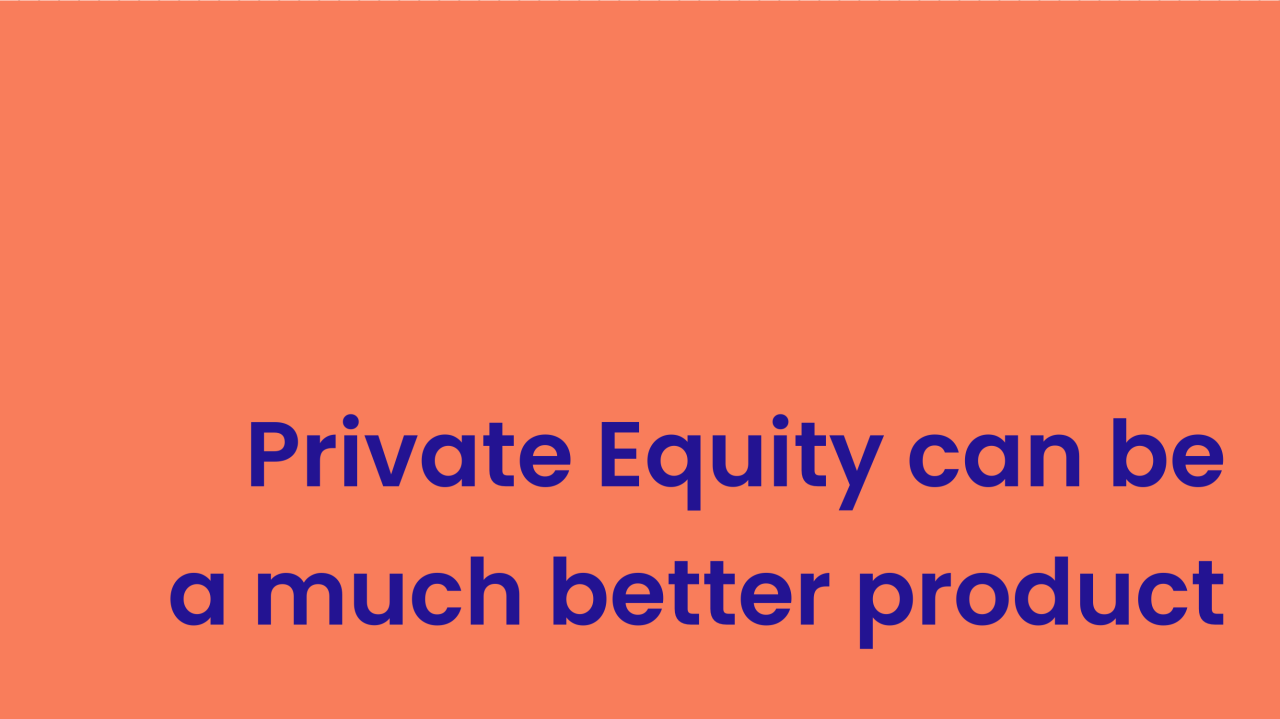A Value-Building Approach You Didn't Expect from PE
Originally published on June 13th, 2025
One of my favorite columnists is Matt Levine at Bloomberg Opinion . He has this not-so-inside joke with his readers that “Everything/Anything can be securities fraud.” He explores a lot of complicated things in the world of business and finance with humor that’s hard to find elsewhere these days. I hope to emulate a bit of what he does with my own thing - “Everything is a product to someone.”
Admittedly, it’s a working title until I can come up with something better, but it also gives me creative license to talk about more things through the lens of building great products.
Today’s segment is about a product sold mostly to large institutional investors: Private Equity!
There have been small attempts to crowdfund this, but we lowly simple folk aren’t really the target audience.
So... what exactly is sold as the product itself? Well, to keep things simple, the first thing that’s sold is a promise by a General Partner to spend money on your behalf on things that’ll hopefully make you some more money in like 7-10 years. (See: Committed Capital) Then, assuming that promise is kept and there is an enticing investment that needs to be bought, they’ll ask you for that money for real and then do the thing.
What’s ultimately sold at the end of it all is a Limited Partnership in a fund (See: Investment Vehicle). Based on how much you put in, and what tier you are, you’ll get paid out some amount of money based on how that fund does.
There are some good and not-so-good things that come with this product compared to other financial products an institution might buy into.
The Good:
Incentive alignment for those who provide and manage the money: The carried interest tends to be larger for more success delivered and lower for less success at the end of the fund’s life. I always thought it was just a flat 2/20 model, but that’s not universally the case, it seems. Trivia: This carried interest concept is actually based on how in the 1600s a ship captain would have their own fee structured for the trouble of taking a ship with cargo around the world and maybe fighting some pirates along the way.
A cooperative and commitment-based approach: You’re literally stuck in a fund for many, many years to ensure the returns come through. Everyone kinda gets a piece of the pie.
Diversification of different kinds of PE: An institutional investor could put money into a fund that buys small companies, medium-sized companies, enterprise software companies, big companies, companies that failed, real estate, and the list goes on. Recently, secondaries have become quite big, and I think I could probably do a whole post on it, but... I’m not educated enough yet to say anything in detail here.
The not-so-good:
I’ve accidentally already covered Diversity and Equity... but unfortunately, there really isn’t much Inclusion (😉) in Private Equity yet.
While PE is open to individuals from all backgrounds in theory, the practical on-ramps are narrow. Fundamentally, you’re just more likely to be in this world if you were made aware of it and groomed for it through specific educational and early-career pathways.
This isn’t just a social issue; it’s a potential product issue.
At an educational level, it’s such a diverse field that you’d think there would be a BS or BA in Private Equity or something, or even a PE concentration in a BS Finance or Economics degree, but largely, no. PE firms kind of act like hospitals and only want permanent staff who’ve gone through a “residency” period at other Investment Banking institutions first. So, it’s a largely gatekept industry and this is a real challenge they’re wrestling with. That “IB residency” is a common path, but firms are starting to look wider.
To be clear, I have many close friends in PE, and they’re clearly not assholes or snobby people. I might have problems with some of the things PE does, but they’re not unsolvable problems.
The Trust Barrier and Group-think
Sometimes we might be better off having common language or some shared set of values to move the needle in the “correct” direction, whatever that may be. So let’s focus on that today: How can PE be a better product for their current customers, but also for a whole host of other people? I really don’t think we need to think zero-sum or negative-sum here.
The PE industry operates on a foundation of immense trust. LPs entrust GPs with billions, asking: Can we trust your ability to raise money? Can we then trust your ability to borrow money well? Can we trust your ability to buy things correctly? Can we trust your ability to operate/improve what you bought (and yes... sell for parts)? Can we trust your ability to stick around for at least a handful of years in one place? If you think about it, these are questions we have for our life partners (including the “sell for parts” conversation! I would love Marie Kondo to help our home be less cluttered and make a home with intention in mind.)
These questions get hard to objectively prove or answer unless you’ve ironically already done some work that people in the industry will understand. There is no credit score for this. There is no defined pathway to getting larger and larger amounts of capital over time unless you really are in the network. All the institutions are there to work with those who are already in that world.
For that reason, I think they can be quite narrow-minded at times, but I’m in the peanut gallery here, so feel free to apply a discount to what I have to say.
That narrow-mindedness, I argue, has created a group-think on what it means to generate returns. And what kind of returns are preferred, at that. And how to achieve those returns. This shared, insular perspective means the industry can develop blind spots, potentially overlooking innovative strategies or different types of investments that fall outside the traditional playbook. It narrows the aperture for what the “product” of private equity is perceived to be and limits the potential for evolving how value is truly created, both for LPs and the companies they invest in.
Another post in the future can probably talk about LBOs, borrowing terms, and how things have been an interesting roller coaster for the last 7-8 years in PE in particular, but for now, I’m going to focus on the cultural aspect of groupthink.
It also creates a problem where often, when someone from the outside offers critical commentary, they’re shunned or dismissed by the industry since the trust isn’t there. The possibility that you might understand their world deeply, despite being an outsider, isn’t a scenario they’ve really gamed out. Even if, for a moment, we assume that’s not the case and the person offering feedback does know the world and is offering commentary on what value should or could mean, well... it’s still pretty difficult to take a hard look in the mirror. This isn’t to excuse any fund or anyone in PE, but it certainly highlights how challenging it can be to be effective in living in a world that is driven more and more by PE actions.
When Bigger Isn’t Necessarily Better
To be clear, they’re not all having a great time. It’s been observed pretty clearly that larger funds aren’t necessarily better at providing returns, and ironically, they have diseconomies of scale. I wish I could have found a more recent study that took into account the ZIRP-era, but who knows, maybe the jury is still out on that? There is a working paper out there by NBER that’s taking a look at this, but using a different proxy to anchor their analysis. Even that paper is saying that a single standard deviation increase in fund size means their IRR goes down hard, plain and simple. WHY it goes down... well, I’ll need to make some popcorn for that at another time.
Redesigning the Product: A Positive-Sum Approach
Overall, it seems to be the case that the standard recipe of buying an undervalued/underperforming business and turning it around isn’t the most notable or readily available way to do PE right now. Additionally, most people hear “Private Equity” and immediately think about roll-ups where long-standing smaller HVAC businesses, car washes, housing communities, HOA managers, or private practices are gobbled up by a large machine designed to print out money for their LPs and nothing else. That is what people see today.
If we view PE as a product, could a more “tasteful” design be more culturally appealing and economically beneficial for a wider range of stakeholders?
As a product, if the model was designed more tastefully, this could be more culturally appealing to the broader population of those that can benefit from Private Equity as another means to build a better life.
We’re already seeing the rise of continuity vehicles or even evergreen funds for certain types of businesses. Today PE is often used to help an HVAC small business owner make an exit, while it leaves an uncertain future for that business owner’s staff.
Maybe... just maybe, more than just the owner could benefit from this transaction? Why couldn’t we instead use the ESOP model to help a whole host of parties all at once when that small business owner wants to exit? In Chapter 4 of the book Staying Private, Ira Starr of Long Point Capital and Matthew Hricko of Stout argue for just that. Business owners can get some nice cash plus some tax advantages, the employees can have even more skin in the game, and since the PE fund can arrange some portion of the debt based on future cash flows, a lot more people can have aligned incentives to make it all work well.
Why isn’t this ESOP model, or variations of it, more central to the PE “product” offering?
Why can’t we do this where everyone can come along for the ride? Of course, the ESOP model doesn’t work for everything, but we have a generation of small businesses that are about to change hands in the next decade. How we go about that transition will literally define a big part of our relationship with capitalism.
Applying a product mindset isn’t just for building apps or good businesses. It’s a lens that lets you look at things like Private Equity and see them as complex designs. Seeing something as a design means it’s not set in stone – it can be questioned and, yes, redesigned.



